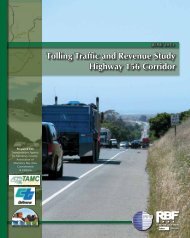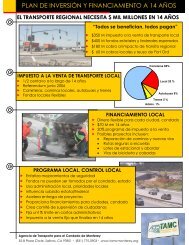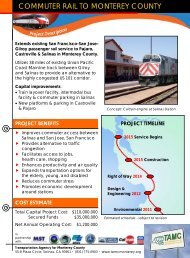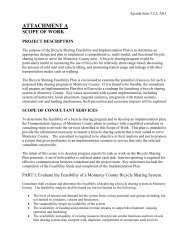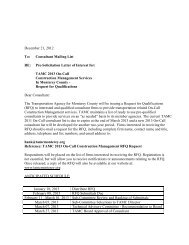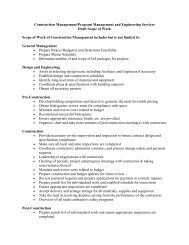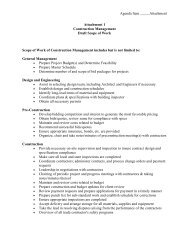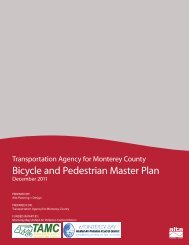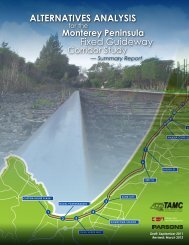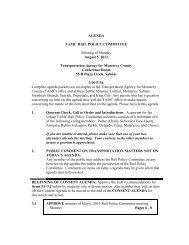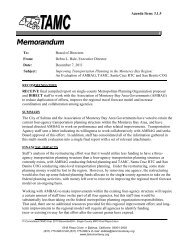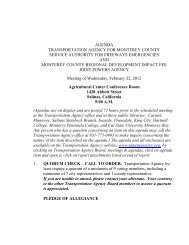Commuter Rail Extension Alternatives Analysis - Transportation ...
Commuter Rail Extension Alternatives Analysis - Transportation ...
Commuter Rail Extension Alternatives Analysis - Transportation ...
You also want an ePaper? Increase the reach of your titles
YUMPU automatically turns print PDFs into web optimized ePapers that Google loves.
CALTRAIN EXTENSION TO MONTEREY COUNTYALTERNATIVES ANALYSISTwo additional forecasting efforts,undertaken for the preparation ofthe PSR were also used for this<strong>Alternatives</strong> <strong>Analysis</strong>.The VTA methodology of utilizingmode shares based on travel distanceswas applied to the censusestimates of county-to-county commutersand the proportion of SantaClara County’s employment baseserved by the Caltrain stations.Table 4-7 reports VTA’s assumptionsregarding transit mode sharesbased on travel distances, whileTable 4-8 reports trip distances andtravel times between MontereyCounty and select Santa Claradestinations. VTA’s assumptionsare similar to those used in 1997 toestablish the feasibility of theWasatch Front (Salt Lake City)commuter rail service.Estimates of Year 2000 commuterstraveling from Monterey Countyand Watsonville to the Bay Areapeninsula counties served by Caltrainare reported in Table 4-9. Thistable indicates that the number ofcommuters assumed to be serviceableby Caltrans is 50 percent ofthe total, based on the tabulation ofcommuter rail access to employmentreported in Table 4-2.Table 4-7Transit Patronage Based onTrip DistanceTransit PercentDistance in Miles Share30 9.0%40 14.0%50 16.5%60 18.6%>70 20.0%Source:645188AA-042Santa Clara Valley <strong>Transportation</strong> AuthorityWasatch Front <strong>Commuter</strong> <strong>Rail</strong> Feasibility StudyRidership Estimation MethodologyThe approach used to develop the ridership estimates for the Wasatch Frontcommuter rail corridor was based on an origin-destination methodology developedby Schiermeyer Consulting Services (SCS), in Orange, California.The methodology focused on identifying commuter travel patterns to majoremployers (employers with more than 100 employees) within a given corridorand applying a “commuter rail mode split” based on rail miles traveled.To begin, major employers located within an approximate 2-mile radius of aproposed destination station were plotted on a regional map. The 2-mileradius was selected as it represents the distance, a surrogate for traveltime, that most commuters are willing to ride a shuttle to reach their finalemployment destination.Origin zip codes were next identified and assigned to specific boardingstations. The origin zip codes represent the “catchment” area of a specificboarding station and may extend much farther than the city or community inwhich the station is located.All major employers were then contacted by letter with telephone follow-up.They were asked to provide a zip code listing of their employees’ homedestinations. After this data was collected and tabulated, mode split factors(based on rail miles traveled) were applied to the total. This subtotal wasthen factored to account for the lack of small employer data.The mode split factors are based on distances (in rail miles) between theboarding and the destination stations. For trips of 15 to 19 miles, a fivepercent mode split was used, 10 percent for trips greater than 20 miles ormore, 15 percent for trips 30 miles or more, 20 percent for trips 40 miles ormore, 25 percent for trips greater than 50 miles, and 30 percent for tripsgreater than 80 miles.One of the critical assumptions in the SCS methodology is the expectationthat at least three round trips trains will be operated during the peak commutingperiods. Experience in Southern California indicates that for commuterrail to be attractive and to meet the varied number of work shiftswithin a given corridor, at least three operating schedules must be provided.If service is started with less than three operating schedules, ridership canbe expected to be reduced by a minimum of 33 percent.Another critical assumption in the ridership estimation process is that adequatesupporting bus service will be in place. In the best case, the commuterrail ticket, whether single ride, multiple ride, or monthly, should alsoinclude the supporting bus service at both the origin and destination end ofthe trip. For predominantly origin stations, such as those where commutersare boarding the train in the morning for travel to work, supporting busservice is relatively unimportant since experience has shown that most railcommuters are automobile owners and typically drove to work prior to theinauguration of rail passenger service. At destination stations, supportingbus service to ensure a quick trip from the station to the final destination,normally the place of work, is essential. Typical commuters will not sacrificemore than 10 minutes from arrival of the train at the destination station toarrival at their final destination.645188AA-080parsons CHAPTER 4: TRAVEL DEMAND FORECASTS 109



